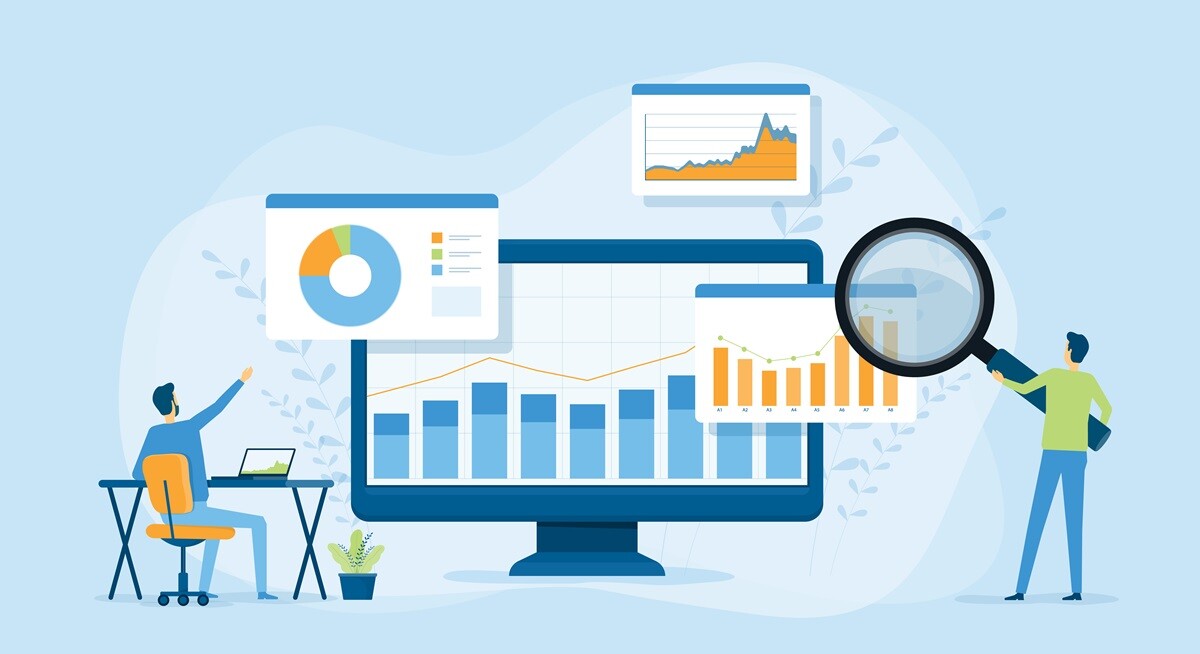
Performance marketing is a dynamic strategy focusing on measurable results, such as clicks, conversions, and sales. Unlike traditional marketing methods that often emphasize brand awareness and broad reach, performance marketing is rooted in accountability and precision. This approach ensures that every marketing effort is tied directly to business outcomes, making it a powerful tool in the digital age where data and analytics drive decisions.
Source: eMarketer
Performance marketing has become increasingly important in today's digital landscape. According to eMarketer, an average of 42% of companies surveyed increased their performance marketing over the last three years versus only 30% of companies who increased their brand marketing. This underscores the growing emphasis on strategies that deliver quantifiable results.
What is Performance Marketing?
Performance marketing is a strategy where advertisers pay marketing service providers based on the success of specific actions. These actions can include clicks on an ad, leads generated, or actual sales. This approach ties payment to achieving concrete metrics, ensuring marketing efforts are directly aligned with business outcomes.
Comparison with Traditional Marketing Methods
Traditional marketing often relies on broad metrics such as impressions, reach, and brand awareness. While useful, these metrics can be challenging to quantify in terms of direct business impact. In contrast, performance marketing focuses on actions that have clear, measurable outcomes. This focus on quantifiable results makes it easier to calculate return on investment (ROI) and allows for real-time adjustments to strategies based on performance data.
Examples of Performance Marketing in Action
- Digital Display Solutions: In the competitive landscape of performance marketing, leveraging the right tools to optimize campaigns and maximize ROI is crucial. Digital display solutions have emerged as a powerful strategy, offering numerous benefits that can significantly enhance marketing efforts. Here’s why these solutions are so effective and how they can drive your marketing success.
- Unmatched Reach and Visibility
Digital display ads are designed to reach a vast audience across multiple platforms, from websites and social media to mobile apps. This extensive reach ensures that your brand is consistently visible to potential customers, enhancing brand awareness and recall. By tapping into networks like the Google Display Network, which reaches over 90% of global internet users, marketers can ensure their ads are seen by a broad and diverse audience. - Precision Targeting
One of the standout features of digital display advertising is its ability to target specific demographics, behaviors, and interests. Advanced targeting options enable marketers to reach their ideal audience more effectively, ensuring that ads are displayed to users who are most likely to convert. This precision targeting enhances campaign efficiency and maximizes return on investment. - Real-Time Analytics and Optimization
Performance marketing relies heavily on data-driven decisions, and digital display solutions excel in providing real-time analytics. These insights allow marketers to track and measure every aspect of their campaigns, enabling quick adjustments and optimizations. The ability to refine targeting and creative elements based on performance data ensures that campaigns remain effective and budget-friendly. - Engaging and Creative Formats
Digital display ads come in various formats, including static banners, interactive rich media, and video ads. This versatility allows marketers to create engaging and visually appealing content that captures the attention of the audience. Creative, eye-catching ads improve user experience and drive higher engagement rates and conversions.
- Unmatched Reach and Visibility
- Pay-Per-Click (PPC) Advertising: Facebook allows advertisers to run performance marketing campaigns where they pay-per-click (PPC) or per thousand impressions (CPM). By using detailed targeting options and continuous A/B testing, advertisers can optimize their campaigns to improve click-through rates and conversions, ensuring they pay only for successful engagements.
- Remarketing for Enhanced Engagement and Conversions: Remarketing is a powerful component of digital display advertising that targets users who have previously interacted with your brand but did not convert. By displaying ads to these users as they browse other websites, remarketing keeps your brand top of mind and encourages them to complete their purchase. This strategy significantly boosts engagement and conversion rates, as it targets an already interested audience with tailored messages that reinforce their decision to buy. Studies show that retargeted ads can lead to a 726% increase in site visits and a 70% increase in conversion rates.
- Affiliate Marketing: Amazon's affiliate program is a classic example of performance marketing. Affiliates earn a commission for driving traffic to Amazon and generating sales through their unique referral links. This performance-based model ensures that Amazon only pays for actual sales, making it a cost-effective marketing strategy.
- Referral Programs: Airbnb effectively uses performance marketing through its referral program. By encouraging users to refer friends and family, Airbnb rewards both the referrer and the referred with travel credits once the new user completes a booking. This strategy boosts user acquisition and leverages word-of-mouth marketing, which consumers highly trust.
Online Performance Marketing
Online performance marketing leverages the internet's vast reach and data capabilities to deliver targeted marketing campaigns. This approach includes using digital channels such as search engines, social media, email, and websites to reach potential customers.
Precise Targeting
Digital platforms offer sophisticated targeting options, allowing marketers to reach specific demographics, interests, and behaviors.
Real-Time Analytics and Attribution
Performance marketing tools provide immediate feedback on campaign effectiveness, enabling marketers to make data-driven adjustments.
In the realm of performance marketing, accurately attributing conversions to the correct touchpoints in the customer journey is crucial. This is where multi-touch attribution (MTA) shines, providing a detailed, context-aware view of how each interaction contributes to the overall conversion process. By utilizing MTA, marketers can gain granular insights into the effectiveness of different channels and tactics, enabling more informed decisions and optimized campaign strategies.
Incorporating MTA is a game-changer for marketers aiming to elevate their performance marketing campaigns. It provides the clarity and data-driven insights necessary to fine-tune marketing efforts, ultimately leading to better outcomes and higher ROAS
Cost-Effectiveness
Businesses can optimize their marketing budgets and improve ROI by paying only for actual performance.
Popular Performance Marketing Platforms and Software
- AffiliateWP: AffiliateWP is a popular WordPress plugin that helps businesses set up and manage their affiliate programs. It integrates seamlessly with WordPress and provides detailed tracking and reporting features to optimize affiliate marketing efforts.
- Tapfiliate: Tapfiliate is an affiliate tracking software that allows businesses to create, track, and optimize affiliate marketing programs. It integrates with various platforms and provides comprehensive analytics to improve campaign performance.
- Referral Rock: Referral Rock helps businesses launch and manage referral programs. It offers features for tracking referrals, rewarding advocates, and analyzing the performance of referral campaigns.
- Trackier: Trackier is a performance marketing software with advanced tracking and optimization tools. It supports multiple marketing channels and offers detailed analytics to help businesses improve their marketing ROI.

Source: Trackier
Developing a Performance Marketing Strategy

Source: Gamesight
Creating a robust performance marketing strategy involves several key steps. It starts with setting clear goals and key performance indicators (KPIs) to measure success.
Steps to Create a Robust Strategy
- Define Your Objectives: Establish what you aim to achieve with your marketing efforts, such as increasing website traffic, generating leads, or boosting sales. Clear objectives provide direction and a basis for measuring success.
- Identify Target Audience: Use data and analytics to understand your audience's demographics, interests, and behaviors. This involves segmenting your audience to tailor your marketing efforts more effectively. Tools like Google Analytics, social media insights, and customer surveys can provide valuable information.
- Select Appropriate Channels: Choose the marketing channels that align with your audience and objectives, such as search engines, social media, or email. Consider where your target audience spends their time and how they prefer to receive information. For example, younger audiences might be more active on Instagram and TikTok, while professionals might prefer LinkedIn.
- Create Compelling Content: Develop engaging content that resonates with your target audience and encourages them to take action. This includes blog posts, videos, infographics, and social media posts that provide value and align with your brand message. High-quality content not only attracts visitors but also builds trust and authority.
- Implement Tracking and Analytics: Use performance marketing tools to monitor campaign progress and measure results. Tools like Google Analytics, Hootsuite, and SEMrush can help you track key metrics such as click-through rates, conversion rates, and return on investment. Review these metrics regularly to understand what's working and make data-driven adjustments to optimize your strategy.
Importance of Setting Clear Goals and KPIs
Clear goals and KPIs provide a roadmap for your marketing efforts, ensuring that every action is aligned with your overall business objectives. They also offer benchmarks for measuring success and identifying areas for improvement. As the saying goes, "What gets measured, gets done." So, ensure that once you set your goals, you also have a plan in place to track them.
Tips for Optimizing Your Strategy
- A/B Testing: Experiment with different versions of ads, landing pages, or emails to determine which performs better. This method allows you to test variables such as headlines, images, call-to-action buttons, and layouts. By systematically comparing two versions, you can identify which elements resonate more with your audience and lead to higher conversion rates.
- Regular Monitoring: Continuously track performance metrics such as click-through rates, conversion rates, and return on investment. Utilize analytics tools to gather data and make informed, data-driven adjustments to improve outcomes. Regular monitoring helps you identify trends, optimize campaigns in real-time, and ensure your marketing efforts align with your business goals.
- Audience Feedback: Gather and analyze feedback from your audience to understand their preferences and pain points. Use surveys, polls, and social media interactions to collect valuable insights. By incorporating audience feedback into your strategy, you can tailor your marketing messages to meet their needs better, improve user experience, and build stronger customer relationships.
Performance Marketing Campaigns
 Source: eMarketer
Source: eMarketer
Performance marketing campaigns come in various forms, each with unique benefits and best practices.
Types of Performance Marketing Campaigns
- PPC & Social Media Advertising: Highly targeted ads that charge advertisers only when a user clicks on the ad.
- Affiliate Marketing: Collaborations with affiliates who promote your products and earn a commission for sales or leads generated.
- Email Marketing: Sending targeted email campaigns to nurture leads and drive conversions.
Best Practices for Running Successful Campaigns
- Audience Segmentation: Group your audience based on demographics, purchase history, and engagement levels to send more targeted messages.
- Clear and Concise Messaging: Keep your messages short and concise, ensuring the main information is easily digestible.
- Strong Call-to-Action (CTA): Encourage recipients to take immediate action, whether it's visiting a website, making a purchase, or participating in a promotion.
- Optimal Timing: Send messages at times when your audience is most likely to engage, avoiding early morning or late-night hours.
- Leverage Automation: Use automation tools to schedule messages and respond to customer interactions in real time.
- Performance Monitoring: Track key metrics such as open rates, click-through rates, and conversions to continually refine your strategy.
Performance Marketing Channels
Performance marketing leverages various channels to reach potential customers and drive actions.
- Social Media: Platforms like Facebook, Instagram, and LinkedIn offer performance-based advertising options that allow businesses to target specific demographics and interests.
- Search Engines: Google Ads and Bing Ads enable businesses to reach users who are actively searching for related products or services.
- Display Advertising: Banner ads and retargeting campaigns on websites to reach users across the internet.
Pros and Cons of Different Channels
- Social Media: High engagement rates but can be costly.
- Search Engines: Highly targeted but competitive.
- Display Advertising: Broad reach but may have lower engagement rates than other channels.
How to Choose the Right Channel for Your Business
When selecting performance marketing channels, consider your business goals, target audience, and budget. Each channel offers unique advantages and can be effective when used strategically.
Performance Marketing Solutions: Key Takeaways
- Performance marketing focuses on measurable results and accountability, ensuring every marketing effort is tied to business outcomes.
- Utilizing performance marketing tools and platforms can enhance the effectiveness of your campaigns by providing real-time insights and analytics.
- Developing a robust performance marketing strategy involves setting clear goals, identifying your target audience, and selecting appropriate channels.
- Running successful performance marketing campaigns requires continuous monitoring, optimization, and leveraging automation tools to maximize ROI.
How Hearst Bay Area Can Help
Hearst Bay Area offers comprehensive performance marketing solutions tailored to your business needs. From PPC advertising and social media campaigns to advanced analytics and strategy development, we provide the tools and expertise to drive measurable results.
Contact us below to learn more about how we can help you implement or enhance your performance marketing campaigns.
Ready to Take Your Business from Great to Awesome?
Level-up your marketing efforts by partnering with Hearst Bay Area, Northern California's largest news media and services group. Get in touch today to see how we can be awesome together:
Recent Posts
What is Contextual Marketing?
Are you tired of shouting your marketing message into the void, hoping someone, anyone, will...
Understanding the Power of Case Studies
Consumers are tired of empty promises. In a world flooded with exaggerated claims, skepticism has...
A Guide to Online Local Business Directories
Every day, local consumers are searching for a business like yours. Whether they find you or a...
.png?width=2083&height=1250&name=HBA_Logo-Black%20(2).png)



